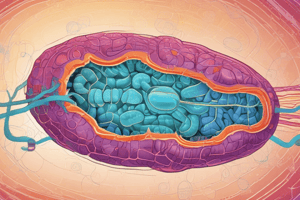Podcast
Questions and Answers
What metabolic process is activated in the liver due to a low insulin to glucagon ratio?
What metabolic process is activated in the liver due to a low insulin to glucagon ratio?
- Glycogenolysis (correct)
- Lipogenesis
- Glycogen synthesis
- Glycolysis
How does the liver respond to increased glucagon levels?
How does the liver respond to increased glucagon levels?
- Decreases fatty acid mobilization
- Activates gluconeogenesis (correct)
- Inhibits protein breakdown
- Promotes glycolysis
What fuels gluconeogenesis during fasting?
What fuels gluconeogenesis during fasting?
- Glucose from glycogen stores
- Cholesterol from lipolysis
- Amino acids from protein breakdown (correct)
- Fatty acids from glycolysis
Which compound produced from fatty acid oxidation activates gluconeogenesis?
Which compound produced from fatty acid oxidation activates gluconeogenesis?
What is the primary effect of lipolysis in the context of energy production?
What is the primary effect of lipolysis in the context of energy production?
How does glucose primarily enter muscle tissue during the fed state?
How does glucose primarily enter muscle tissue during the fed state?
What is one of the effects of the fall in insulin levels during fasting on muscle tissue?
What is one of the effects of the fall in insulin levels during fasting on muscle tissue?
What is the fate of fatty acids that enter muscle tissue from both the diet and the liver?
What is the fate of fatty acids that enter muscle tissue from both the diet and the liver?
In adipose tissue during the fed state, how is glucose metabolized?
In adipose tissue during the fed state, how is glucose metabolized?
During early fasting, what significant metabolic change occurs in the liver?
During early fasting, what significant metabolic change occurs in the liver?
What effect does insulin have on lipoprotein lipase (LPL) activity in adipose tissue?
What effect does insulin have on lipoprotein lipase (LPL) activity in adipose tissue?
Which transporters are involved in glucose uptake by the brain?
Which transporters are involved in glucose uptake by the brain?
What happens to glycerol released from triacylglycerols in adipose tissue?
What happens to glycerol released from triacylglycerols in adipose tissue?
What happens to glucose levels when plasma glucose falls in the liver during early fasting?
What happens to glucose levels when plasma glucose falls in the liver during early fasting?
What is a primary role of the liver during gluconeogenesis?
What is a primary role of the liver during gluconeogenesis?
How does a low insulin to glucagon ratio affect glucose metabolic processes in the liver?
How does a low insulin to glucagon ratio affect glucose metabolic processes in the liver?
During starvation, which fuel source does muscle primarily utilize?
During starvation, which fuel source does muscle primarily utilize?
What effect do ketone bodies have on muscle during fasting?
What effect do ketone bodies have on muscle during fasting?
What occurs to fatty acids in the liver during the production of ketone bodies?
What occurs to fatty acids in the liver during the production of ketone bodies?
What is the primary metabolic state in muscle when insulin levels drop significantly?
What is the primary metabolic state in muscle when insulin levels drop significantly?
What triggers the mobilization of triglycerides (TGs) in adipose tissue during the early fasting state?
What triggers the mobilization of triglycerides (TGs) in adipose tissue during the early fasting state?
Which transport systems allow the brain to continue taking up glucose during fasting?
Which transport systems allow the brain to continue taking up glucose during fasting?
What is the primary energy source the body switches to during the starved state?
What is the primary energy source the body switches to during the starved state?
Why does glycogenolysis not occur in skeletal muscle?
Why does glycogenolysis not occur in skeletal muscle?
How does the metabolism of glucose in adipose tissue during the early fasting state change?
How does the metabolism of glucose in adipose tissue during the early fasting state change?
What happens to glycerol during times of nutrient deprivation?
What happens to glycerol during times of nutrient deprivation?
What is primarily dependent on gluconeogenesis in the liver after glycogen stores are depleted?
What is primarily dependent on gluconeogenesis in the liver after glycogen stores are depleted?
Why can't the brain switch to fatty acids as a fuel source during fasting?
Why can't the brain switch to fatty acids as a fuel source during fasting?
What does cAMP PK do to glycogen synthase?
What does cAMP PK do to glycogen synthase?
Which enzyme phosphorylates phosphorylase, thus activating it?
Which enzyme phosphorylates phosphorylase, thus activating it?
How is phosphorylase kinase activated allosterically?
How is phosphorylase kinase activated allosterically?
What effect does insulin have on glycogen metabolism?
What effect does insulin have on glycogen metabolism?
In the liver, what second messenger does glucagon use to stimulate glycogenolysis?
In the liver, what second messenger does glucagon use to stimulate glycogenolysis?
What is the role of phosphorylase kinase in regulating glycogen metabolism?
What is the role of phosphorylase kinase in regulating glycogen metabolism?
What is required for effective glycogen metabolism to prevent futile cycling of intermediates?
What is required for effective glycogen metabolism to prevent futile cycling of intermediates?
What triggers glycogen degradation in both muscle and liver during stress?
What triggers glycogen degradation in both muscle and liver during stress?
Study Notes
Metabolism in the Fed State
- Glycerol Metabolism: Glycerol from peripheral tissues converts to triacylglycerols and enters the TCA cycle.
- Amino Acid Fate: Excess amino acids from the gut convert to pyruvate, metabolized via the TCA cycle for energy or converted to triacylglycerols.
Muscle Metabolism During Fed State
- Glucose Uptake: Insulin-mediated Glut 4 transport system facilitates glucose entry; glucose is converted to glycogen or metabolized via glycolysis and TCA cycle.
- Fatty Acid Oxidation: Fatty acids from chylomicrons and VLDL oxidize via β-oxidation to acetyl CoA, producing ATP for muscle contraction.
- Protein Synthesis: Amino acids are utilized for protein synthesis.
Adipose Tissue Metabolism During Fed State
- Glucose Entry: Glucose enters adipose tissue through Glut 4, converting to acetyl CoA, then to fatty acids and triacylglycerols.
- Fatty Acid Storage: Fatty acids from VLDL and chylomicrons convert into triacylglycerols; LPL activity increases while HSL is inhibited by insulin.
- Glycerol Recycling: Glycerol released from triacylglycerols returns to the liver for reuse.
Brain Metabolism During Fed State
- Glucose Uptake: Brain utilizes glucose through Glut 1 & 3 transporters and metabolizes it oxidatively via glycolysis and TCA cycle to produce ATP.
Early Fasting State
- Liver Glucose Shift: Liver transitions from a glucose-utilizing to a glucose-producing organ; glycogen synthesis decreases while glycogenolysis and gluconeogenesis increase.
- Insulin/Glucagon Ratio: A reduced insulin to glucagon ratio activates glycogenolysis and gluconeogenesis from lactate and alanine.
Liver Metabolism in Early Fasting State
- Glucose Export: Glucose entry halts as Glut 2 transporter affinity decreases; liver exports glucose instead.
- Lipolysis Activation: Mobilization of fatty acids from triacylglycerols occurs; fatty acids are oxidized for energy.
- Amino Acid Breakdown: Proteins are broken down to amino acids, fueling gluconeogenesis with fatty acids providing additional energy.
Muscle Metabolism in Early Fasting State
- Decreased Glucose Entry: A fall in insulin reduces glucose entry; glycogenolysis does not occur due to lack of glucagon receptors in muscle.
- Fatty Acid Utilization: Muscle shifts energy source to fatty acid oxidation, inhibiting glucose use.
- Proteolysis: Protein breakdown supplies amino acids for energy or for gluconeogenesis.
Adipose Tissue Metabolism in Early Fasting State
- Reduced Glucose Entry: Insulin decrease limits glucose uptake via Glut 4; glycolysis of glucose is inhibited.
- Triacylglycerol Mobilization: Triacylglycerol breakdown is activated by low insulin and noradrenaline; fatty acids contribute to energy production.
- Glycerol Recycling: Glycerol is recycled to the liver for gluconeogenesis.
Brain Metabolism in Early Fasting State
- Continued Glucose Uptake: High affinity of Glut 1 and 3 allows glucose uptake despite fasting.
- Inefficiency with Fatty Acids: Brain cannot utilize fatty acids as fuel due to the blood-brain barrier; it relies solely on glucose metabolism.
Metabolism in the Starved State
- Chronic Hormonal State: Low insulin and high glucagon predominance; thyroid hormones decrease, lowering metabolic rate.
- Primary Energy Source: Free fatty acids become the main energy source, and ketone bodies are produced as an alternative fuel.
Liver Metabolism in Starved State
- Depleted Glycogen: Liver glycogen stores deplete within 24 hours; plasma glucose relies on gluconeogenesis.
- Amino Acids and Gluconeogenesis: Amino acids from protein breakdown support gluconeogenesis, and fatty acids from lipolysis provide energy for this process.
- Ketone Body Production: Excess acetyl CoA from fatty acid oxidation is converted to ketone bodies for use by other tissues.
Muscle Metabolism in Starved State
- Fatty Acids as Fuel: Glucose entry is minimal, and muscle switches to fatty acids for energy.
- Utilization of Ketone Bodies: Ketone bodies are absorbed and used as additional fuel, reducing muscle wasting by conserving glucose.
Glucose-Fatty Acid Cycle
- Energy Regulation: Fatty acid oxidation spares glucose; cAMP activates phosphorylase kinase, while glycogen synthase is inhibited to prevent futile cycling.
Glycogen Metabolism Regulation
- Phosphorylation Mechanisms: Phosphorylase kinase activation leads to glycogen breakdown; muscle contraction is linked to glycogen breakdown via Ca2+ signaling.
- Insulin Action: Insulin activates protein phosphatase-1, promoting glycogen synthesis and inhibiting breakdown.
Summary of Glycogen Regulation
- Coordinated Control: Efficient glycogen metabolism requires regulated activity of phosphorylase and glycogen synthase to prevent futile cycling of intermediates.
Studying That Suits You
Use AI to generate personalized quizzes and flashcards to suit your learning preferences.
Related Documents
Description
This quiz explores the metabolic processes activated in the liver due to hormonal changes, particularly during fasting states. It covers how the liver responds to glucagon, the role of gluconeogenesis, and the effects of lipolysis and insulin on muscle tissue. Test your knowledge on these crucial biochemical pathways!




